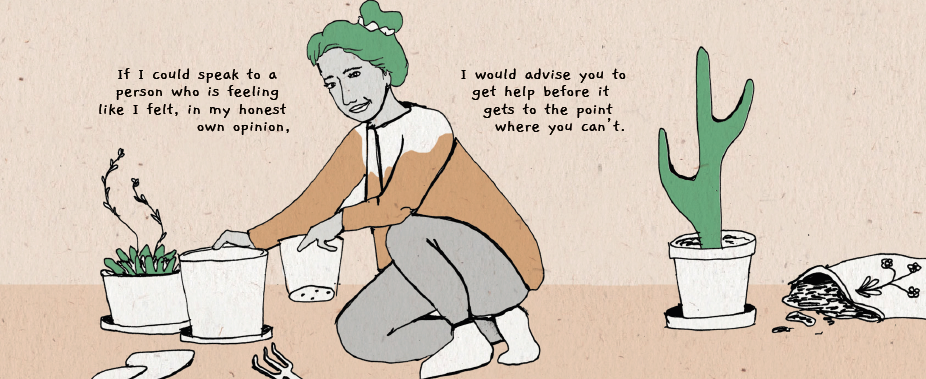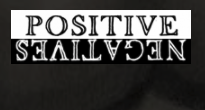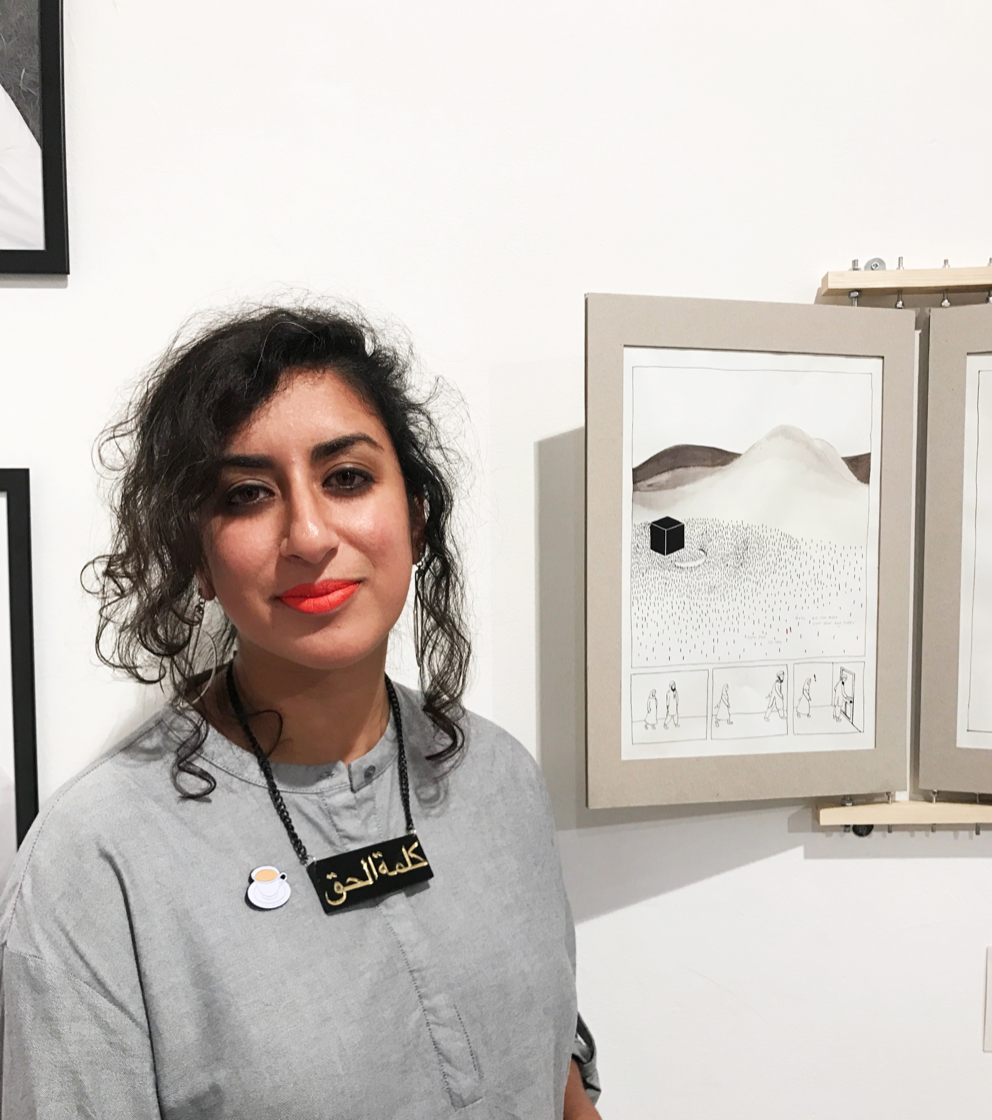Sabba Khan is the artist for EachOther’s first ever comic strip, which has taken around eighteen months to create and is being released slowly on our website from its launch on Human Rights Day 10 December through to 4th January – to allow for people who might find the holiday season difficult, to read a story where they might recognise their own, and be able to reach out for help if they need it. This slow release of the 48 panels within the comic means you’ll need to keep coming back to get the full story over its launch.
It took me five years to complete my graphic novel, The Roles We Play, but if you read it in one sitting it would take you approximately two and a half hours to read. Its something a lot of comics creators complain of, but really I think there’s something deeper to it. Author of Biscuits, Jenny Robins, puts it well ‘We don’t complain that a film takes ages to make but only a few hours to watch, so why should we with graphic novels?’. And she’s right about linking the two formats. Graphic novels and comics in themselves are a hybrid medium (are they art? Are they literature? Are they both? Are you an artist or an author or both?) and because of the way you consume them, sit at the intersection of books and film. The way the story unpacks creates a thrilling, consumptive liminal space for the reader, one where the reader is an active participant in bringing together both the writing and the drawing; comics are an experience.
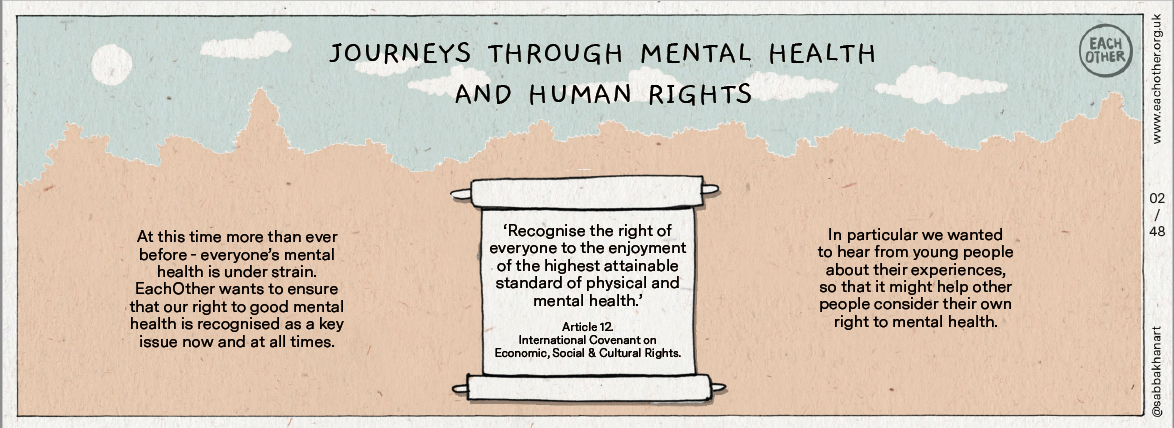
© Sabba Khan 2021 extract panel from Journeys Through Mental Health
Graphic novels and comics though traditionally associated with super-heroes and villains have become so much more. For me, the power of comics lies in its ability to fuse themes, genres and topics together. I’m thinking of Una’s Becoming/Unbecoming, or Isaac’s Wolf of Baghdad, the former a critical merging of the artist’s own personal experiences against the historic and cultural backdrop of 80’s Yorkshire, and the latter a hybrid musical-visual-performance-come-graphic-novel looking at the lost communities of the Iraqi Jews of Bhagdad. Both are rich, complex and layered.
My own graphic novel looks at my lived experiences and my family’s migration history under the backdrop of post-war 90’s London. I provide myself a space to critique, reflect and grow within its pages, and so it becomes a vulnerable yet moving experience for the reader to share. I delve into a largely unspoken and unacknowledged part of British history – the Mirpuri migration and its place in understanding contemporary south asian diaspora culture, and review themes around race, gender, religion and class.
Lived experience, defined as “personal knowledge about the world gained through direct, first-hand involvement in everyday events”, is a central premise of my practice. I use comics and visual stories to illustrate people’s lived experience; those often dismissed moments that when unpacked, show us that our journey is not just individual or solitary, but that these moments are indicators of wider societal pressures, or nods to systemic violence.
(Marvel inspired gif of Journeys Through Mental Health )
The focus on lived experience came alive for me when I began working with SOAS university researchers and Positive Negatives. We created an animation that brought together three years of interviews of students and staff across universities in the UK – charting the effects of Prevent legislation on Muslims in higher education five years on from its implementation into civic society. Compiled in a type of babushka doll nest, the interviews when brought together created a powerful testimony against the impacts of Prevent, and how it’s adverse affects can be felt not only in higher education (which the research was focused on) but all spheres of life. The animation was used as a hook into the research data which highlighted the need to review the way Prevent reinforced negative view about Muslims and Islam.
The focal point for my work with EachOther, similar to the work with SOAS, has been to galvanise the lived mental health experience amongst young adults. We wanted to give colour and complexity to the stories that we were hearing and how the impact of reduced services for mental health provisions has impacted our youth. The premise of the comic is to encourage and normalise talking about mental health and well as point to provisions and access to help for when it is needed. The stories are bookended by a group of friends meeting up in person to chat and have a cup of tea. Each story takes us on a chronological journey starting with their background context, the mental health journey itself, and the challenges and gains made along the way. Each story followed the rough trajectory of the interviews held by EachOther’s Creative Director, Sarah Wishart, with all conversations ending with the opportunity for the young people to discuss the way they’d want to different things in the world. This allowed us to make space within the comic for the participants to imagine alternative possibilities alongside telling the story of their journeys.
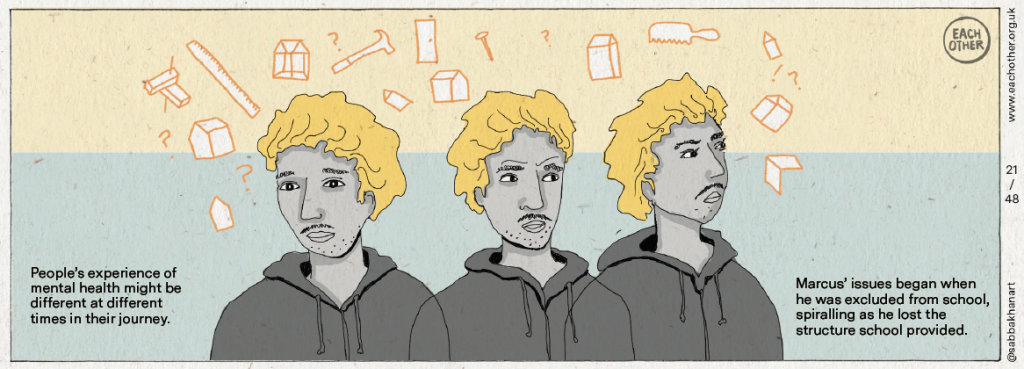
Marcus’ story © Sabba Khan 2021 – extract panel from Journey Through Mental Health
Each character is accompanied with a set of line symbols to represent their state of emotion. The colours match their hair colour – the emotions are a part of the character’s identity. These are shown as lingering, almost haunting elements, sometimes engulfing, sometimes fragmented to visualise what intangible emotional states may feel like. Each character comes to represent different themes; Tia’s journey is about grief, loss of loved ones; Marcus’ journey looks at the breakdown of school structures, Ray’s journey reflects on changing family structures.
It was important to stay true to the oral interviews and to honour each person’s unique stories- therefore each story is only gently curated to help the reader along.
The comic strip will be fully revealed on 4th January 2022

